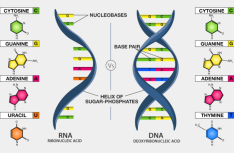
Vaccsbook

Infectious Diseases . . . and How to Avoid Them
DNA and RNA

This information is for entertainment purposes only. It has not been verified by a third party. Last updated: a while ago.
DNA
DNA and RNA are found in every cell of every living organism: humans, animals, microbes, and plants.
DNA is made up of four simple molecules called Nucleotides, whose names are abbreviated to A, T, G, and C.
These are combined into very long chains, some with billions of nucleotides;
each chain is distinguished from others by the sequences of A,T,C,G.
When two (of the same) chains intertwine, a very large molecule called DNA is formed;
the shape and structure is known as the "double helix" and was first discovered in 1953.
In turn, thousands of DNA molecules collect together to form a Gene, and thousands of genes join together to form a Chromosome.
Chromosomes exist in the nucleus of every cell.
Different species have differing numbers of chromosomes.
Humans usually have 46 chromosomes, although in rare instances people are born with 45 or 47.
Cats have 38 chromosomes, sugarcane has 80, the African hedgehog has 90.
Every individual has different DNA (except for identical twins).
For a particular gene in a particular chromosome, the sequence of A,T,C,G varies slightly from one
individual to the next.
Genes determine who we are, what we look like, and most important, how susceptible we are to a disease and whether we will be able to fight it off.
RNA
DNA is like an individual's blueprint; RNA turns that blueprint into biological action.
DNA is only found in the nucleus of each cell, not so with RNA.
An RNA molecule has the same basic molecular structure as DNA, but usually exists as a single chain instead of the double helix configuration.
The three main types of RNA are called Messenger (mRNA), Transfer (tRNA), and Ribosomal (mRNA).
The genetic information on DNA is "copied" to mRNA; mRNA is then transported outside the cell's nucleus
where tRNA and rRNA use it to make the all important proteins.
These proteins in turn make and repair tissues, organs, blood cells, enzymes, hormones etc.
and importantly, the components of an individual's immune system.
mRNA is newsworthy as the basis for some COVID-19 vaccines.
DNA Vaccines
DNA vaccines comprise specific anti-viral chains (of the A,T,C,G nucleotides) which normal cellular processes
then use to make anti-viral proteins (antigens).
As of mid-2021, there are no DNA vaccines approved for human use, but trials are ongoing for HIV, West Nile and Zika viruses.
mRNA Vaccines
mRNA vaccines comprise mRNA molecules that are not from an individual's own DNA, but made in a laboratory using parts of viral mRNA.
When injected, normal cellular processes produce virus-like proteins (antigens) which stimulate the immune system to produce antibodies.
As of mid-2019, the U.S. National Institute of Allergy and Infectious Diseases (Dr. A. Fauci, director)
considered DNA & mRNA vaccines to be "investigational".
Starting in November 2020, a number of countries authorized
mRNA vaccines for emergency use in the prevention of COVID-19;
but as of April 2021 no mRNA vaccine had received general approval.